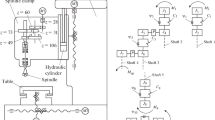Abstract
Machining vibrations are harmful to workpiece surface quality and tool life, especially for thin-walled parts. A lightweight damping device is proposed by utilizing eddy current damping, and it can be easily attached onto the workpiece surface by glue. The cylindrical device is mainly composed of a magnet, an aluminum cylindrical conductor, and two springs. An induced repulsive force due to the machining vibration is generated and transmitted to the workpiece and then contributed to the vibration attenuation. Dynamic response evaluation on a cantilever beam by hammer tests demonstrates that the device is able to damp vibration mode and the effect of additive mass on the beam dynamics is investigated by roving the attaching point. Moreover, the device is applied to damp multiple modes and attenuate machining vibration of a thin-walled frame. Machining tests under different configurations of cutting parameters are carried out, and its effectiveness of wide band and adaptability to the varying machining processes are validated.
Similar content being viewed by others
References
Guillem Q, Joaquim C (2011) Chatter in machining process: a review. Int J Mach Tool Manuf 51(5):363–376
Altintas Y (2012) Manufacturing automation, 2nd edn. Cambridge University Press, Cambridge
Adetoro OB, Sim WM, Wen PH (2010) An improved prediction of stability lobes using nonlinear thin wall dynamics. J Mater Process Technol 210(6):969–979
Zhou X, Zhang D, Luo M, Wu B (2014) Tool path dependent chatter suppression in multi-axis milling of hollow fan blades with ball-end cutter. Int J Adv Manuf Technol 72(5–8):643–651
Dosch JJ, Inman DJ, Garcia E (1992) A self-sensing piezoelectric actuator for collocated control. J Intell Mater Syst Struct 3(1):166–185
Kumar R, Mishra BK, Jain SC (2008) Thermally induced vibration control of cylindrical shell using piezoelectric sensor and actuator. Int J Adv Manuf Technol 38(5–6):551–562
Tasi CN, Shih LW, Lee RM (2010) Spindle vibration suppression for advanced milling process by using self-tuning feedback control. Int J Adv Manuf Technol 48(1–4):1–10
Ormondroyd J (1928) Theory of the dynamic vibration absorber. Trans ASME 50:9–22
Den Hartog JP (1947) Mechanical vibrations. McGraw-Hall, New York
Brock JE (1946) A note on the damped vibration absorber. J Appl Mech 13(4):A284
Rashid A, Cornel MN (2008) Design and implementation of tuned viscoelastic dampers for vibration control in milling. Int J Mach Tool Manuf 48(9):1036–1053
Wang M (2011) Feasibility study of nonlinear tuned mass damper for machining chatter suppression. J Sound Vib 330(9):1917–1930
Yang Y, Munoa J, Altintas Y (2010) Optimization of multiple tuned mass dampers to suppress machine tool chatter. Int J Mach Tool Manuf 50(9):834–842
Zuo L, Nayfeh SA (2006) The two-degree-of-freedom tuned-mass damper for suppression of single-mode vibration under random and harmonic excitation. J Vib Acoust 128(1):56–65
Mao K, Wang M, Xu Z, Chen T (2004) Simulation and characterization of particle damping in transient vibrations. J Vib Acoust 126(2):202–211
Kolluru K, Axinte D, Becker A (2013) A solution for minimizing vibrations in milling of thin walled casings by applying dampers to workpiece surface. Ann CIRP 62:415–418
Moon FC, Pao YH (1969) Vibration and dynamic instability of a beam-plate in a transverse magnetic field. J Appl Mech 36(1):92–100
Wiederick HH, Gauthier N, Campbell DA (1987) Magnetic braking: simple theory and experiment. Am J Phys 55:500–503
MacLatchy CS, Backman P, Bogan L (1993) A quantitative magnetic braking experiment. Am J Phys 61(12):1096–1101
Sodano H, Bae JS, Inman DJ, Belvin WK (2005) Concept and model of eddy current damper for vibration suppression of a beam. J Sound Vib 288(4):1177–1196
Babak E, Mir BK, Farid G (2010) Permanent magnet configuration in design of an eddy current damper. Microsyst Technol 16(1–2):19–24
Bae JS, Hwang JH, Roh JH, Kim JH, Yi MS, Lim JH (2012) Vibration suppression of a cantilever beam using magnetically tuned-mass-damper. J Sound Vib 331(26):5669–5684
Yang Y, Xu D, Liu Q (2014) Vibration suppression of thin-walled workpiece machining based on the electromagnetic induction. Mater Manuf Process. doi:10.1080/10426914.2014.962042
Author information
Authors and Affiliations
Corresponding author
Rights and permissions
About this article
Cite this article
Yang, Y., Xu, D. & Liu, Q. Milling vibration attenuation by eddy current damping. Int J Adv Manuf Technol 81, 445–454 (2015). https://doi.org/10.1007/s00170-015-7239-3
Received:
Accepted:
Published:
Issue Date:
DOI: https://doi.org/10.1007/s00170-015-7239-3



